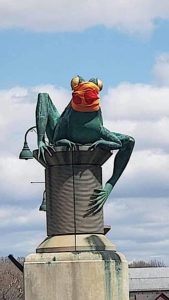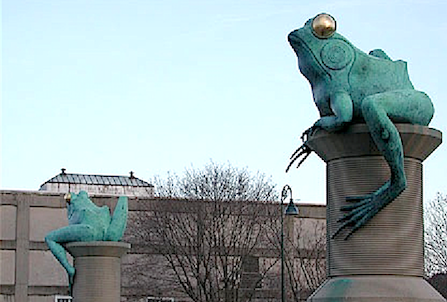Why these frogs symbolize our changing culture.
 The most unique contribution of sculpture ever to grace a bridge is in the town of Willimantic, Connecticut. Leo Jensen’s huge 3,000-pound frogs sitting atop giant thread spools are symbols of the town’s history. Now they also bring pride, hope, and optimism.
The most unique contribution of sculpture ever to grace a bridge is in the town of Willimantic, Connecticut. Leo Jensen’s huge 3,000-pound frogs sitting atop giant thread spools are symbols of the town’s history. Now they also bring pride, hope, and optimism.
Granted, giant amphibians are among the most unlikely sculptures that one might imagine for a bridge. Consider instead the stark contrast of the stately Alexander III bridge spanning the river Seine in Paris. Leading the way to the Eiffel Tower, its prominent art nouveau bronzes at both ends of the bridge feature a female figure restraining a restless Pegasus — all in gleaming gold. Here in America, Washington, D.C. leads the way with Leo Friedlander’s robustly muscular The Arts of War, Art Deco groups of horse and rider poised at the entrance of the bridge crossing the Potomac River as they point the way to Arlington Memorial Cemetery. Appropriately on the other side of the bridge is James Earle Fraser’s Neoclassical group, The Arts of Peace. The nation’s capitol also boasts Alexander Phimister Proctor’s four bison figures at the ends of the Dumbarton Bridge erected in 1914 — honoring the heart of a Native American culture that had virtually vanished from the Great Plains.
Jenson’s apparently silly frogs may not seem distinguished enough to be compared with those iconic bridge figures by Friedlander, Fraser, and Proctor but they play an important role. They, too, are testaments to significant culture-changing events that continue to recur. Jensen’s 12-foot tall bronze frogs with gilded eyes are perched atop the piers at the corners of each end of the bridge. Each frog straddles above a 10-foot cement thread spool. But why frogs? The story of the Great Windham Frog Fight of 1754 is too long to tell here but frogs — along with thread spools — became traditional symbols of the city. In mid 19th century Connecticut, numerous inventors led the state to prominence in America’s Industrial Age. Willimantic stood out for its thread mill, the largest in North America. It boomed for more than 150 years. By the 1960s, the state’s factories had begun to shut down. As production shifted overseas, hundreds of thousands of workers lost their jobs. The Willimantic Mills held out until closing its doors 1985. Willimantic even lost its standing as a city and was instead incorporated into the town of Windham. Its poverty level skyrocketed as the state’s highest and it became known as “Heroin Town.” In 2003 “Sixty Minutes” ran an investigative segment on its severe decline.
In a town has nothing in common with Disneyland, “Frog Bridge” continues to surprise unsuspecting motorists. Thanks to an idiosyncratic Pop sculptor, this gateway is funneling hope to the town. The frogs stand as a tribute not only to a vanished city but to all the industries that originally generated New England’s prosperity. Today they are wearing PPE masks. As if covid-19 weren’t enough, North American amphibians suffer from the very real and mysteriously widespread outbreak of FV3 (Frog Virus 3). That’s another reason why frogs are appropriate symbols of looming changes set in motion across the country. Significant changes —environmental, pathological, and cultural — prove to reappear throughout history. Fortunately, those early Connecticut Yankees passed down to us the essential spirit to win this battle: perseverance, optimism, and innovation. That’s the take-away from those giant frogs on the bridge. Come December you can be sure they will be newly-dressed, this time with red scarves for Christmas. In the meantime, here at DIAA we are exploring the most effective new ways to engage with compelling content that promises to take us beyond the simplicity of digital images, inviting us to experience fine art in a new way…and to acquire it.
Peter Hastings Falk
ABOUT LEO JENSEN

Leo Jensen is the only American artist who actually grew up in the circus. During the 1960s he became a seminal figure in Pop Art in New York. He was the first to create kinetic Pop sculpture. Read his extraordinary backstory here and discover how he influenced Tom Wesselman. Leo is a truly unique character in the history of American Art.

